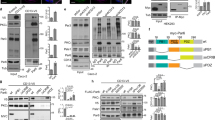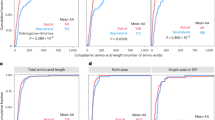Abstract
Targeted delivery of proteins to distinct plasma membrane domains is critical to the development and maintenance of polarity in epithelial cells. We used confocal and time-lapse total internal reflection fluorescence microscopy (TIR-FM) to study changes in localization and exocytic sites of post-Golgi transport intermediates (PGTIs) carrying GFP-tagged apical or basolateral membrane proteins during epithelial polarization. In non-polarized Madin Darby Canine Kidney (MDCK) cells, apical and basolateral PGTIs were present throughout the cytoplasm and were observed to fuse with the basal domain of the plasma membrane. During polarization, apical and basolateral PGTIs were restricted to different regions of the cytoplasm and their fusion with the basal membrane was completely abrogated. Quantitative analysis suggested that basolateral, but not apical, PGTIs fused with the lateral membrane in polarized cells, correlating with the restricted localization of Syntaxins 4 and 3 to lateral and apical membrane domains, respectively. Microtubule disruption induced Syntaxin 3 depolarization and fusion of apical PGTIs with the basal membrane, but affected neither the lateral localization of Syntaxin 4 or Sec6, nor promoted fusion of basolateral PGTIs with the basal membrane.
This is a preview of subscription content, access via your institution
Access options
Subscribe to this journal
Receive 12 print issues and online access
$209.00 per year
only $17.42 per issue
Buy this article
- Purchase on SpringerLink
- Instant access to full article PDF
Prices may be subject to local taxes which are calculated during checkout







Similar content being viewed by others
References
Rodriguez-Boulan, E. & Nelson, W.J. Morphogenesis of the polarized epithelial cell phenotype. Science 245, 718–725 (1989).
Simons, K. & Wandinger-Ness, A. Polarized sorting in epithelia. Cell 62, 207–210 (1990).
Keller, P., Toomre, D., Diaz, E., White, J. & Simons, K. Multicolour imaging of post-Golgi sorting and trafficking in live cells. Nature Cell Biol. 3, 140–149 (2001).
Rodriguez-Boulan, E. & Gonzalez, A. Glycans in post-Golgi apical targeting: sorting signals or structural props? Trends Cell Biol. 9, 291–294 (1999).
Chuang, J.Z. & Sung, C.H. The cytoplasmic tail of rhodopsin acts as a novel apical sorting signal in polarized MDCK cells. J. Cell Biol. 142, 1245–1256 (1998).
Le Gall, A., Yeaman, C., Muesch, A. & Rodriguez-Boulan, E. Epithelial cell polarity: new perspectives. Sem. Nephrol. 15, 272–284 (1995).
Ikonen, E. & Simons, K. Protein and lipid sorting from the trans-Golgi network to the plasma membrane in polarized cells. Semin Cell Dev Biol 9, 503–509 (1998).
Toomre, D., Keller, P., White, J., Olivo, J.C. & Simons, K. Dual-color visualization of trans-Golgi network to plasma membrane traffic along microtubules in living cells. J. Cell Sci. 112, 21–33 (1999).
Kreitzer, G., Marmorstein, A., Okamoto, P., Vallee, R. & Rodriguez-Boulan, E. Kinesin and dynamin are required for post-Golgi transport of a plasma-membrane protein. Nature Cell Biol. 2, 125–127 (2000).
Bonifacino, J.S. & Dell'Angelica, E.C. Molecular bases for the recognition of tyrosine-based sorting signals. J. Cell Biol. 145, 923–926 (1999).
Ohno, H. et al. The medium subunits of adaptor complexes recognize distinct but overlapping sets of tyrosine-based sorting signals. J. Biol. Chem. 273, 25915–25921 (1998).
Kirchhausen, T. Adaptors for clathrin-mediated traffic. Annu. Rev. Cell Dev. Biol. 15, 705–732 (1999).
Kirchhausen, T., Bonifacino, J.S. & Riezman, H. Linking cargo to vesicle formation: receptor tail interactions with coat proteins. Curr. Opin. Cell Biol. 9, 488–495 (1997).
Noda, Y. et al. KIFC3, a microtubule minus end-directed motor for the apical transport of annexin XIIIb-associated Triton-insoluble membranes. J. Cell Biol. 155, 77–88 (2001).
Nakagawa, T. et al. A novel motor, KIF13A, transports mannose-6-phosphate receptor to plasma membrane through direct interaction with AP-1 complex. Cell 103, 569–581 (2000).
Setou, M., Nakagawa, T., Seog, D.H. & Hirokawa, N. Kinesin superfamily motor protein KIF17 and mLin-10 in NMDA receptor-containing vesicle transport. Science 288, 1796–1802 (2000).
Bacallao, R. et al. The subcellular organization of Madin-Darby Canine Kidney cells during the formation of a polarized epithelium. J. Cell Biol. 109, 2817–2832 (1989).
Gilbert, T., Le Bivic, A., Quaroni, A. & Rodriguez-Boulan, E. Microtubular organization and its involvement in the biogenetic pathways of plasma membrane proteins in Caco-2 intestinal epithelial cells. J.Cell Biol. 113, 275–288 (1991).
Grindstaff, K.K., Bacallao, R.L. & Nelson, W.J. Apiconuclear organization of microtubules does not specify protein delivery from the trans-Golgi network to different membrane domains in polarized epithelial cells. Mol. Biol. Cell 9, 685–699 (1998).
Schmoranzer, J., Goulian, M., Axelrod, D. & Simon, S.M. Imaging constitutive exocytosis with total internal reflection fluorescence microscopy. J. Cell Biol. 149, 23–32 (2000).
Achler, C., Filmer, D., Merte, C. & Drenckhahn, D. Role of microtubules in polarized delivery of apical membrane proteins to the brush border of the intestinal epithelium. J. Cell Biol. 109, 179–189 (1989).
Breitfeld, P.P., Mckinnon, W.C. & Mostov, K.E. Effect of nocodazole on vesicular traffic to the apical and basolateral surfaces of polarized Madin-Darby canine kidney cells. J. Cell. Biol. 111, 2365–2373 (1990).
Rindler, M.J., Ivanov, I.E. & Sabatini, D.D. Microtubule-acting drugs lead to the nonpolarized delivery of the influenza hemagglutinin to the cell surface of polarized Madin-Darby canine kidney cells. J. Cell Biol. 104, 231–241 (1987).
Matter, K., Bucher, K. & Hauri, H.P. Microtubule perturbation retards both the direct and the indirect apical pathway but does not affect sorting of plasma membrane proteins in intestinal epithelial cells (Caco-2). EMBO J. 9, 3163–3170 (1990).
Lafont, F., Burkhardt, J. & Simons, K. Involvement of microtubule motors in basolateral and apical transport in kidney cells. Nature 372, 801–803 (1994).
Hugon, J.S., Bennett, G., Pothier, P. & Ngoma, Z. Loss of microtubules and alteration of glycoprotein migration in organ cultures of mouse intestine exposed to nocodazole or colchicine. Cell Tissue Res. 248, 653–662 (1987).
Saunders, C. & Limbird, L.E. Disruption of microtubules reveals two independent apical targeting mechanisms for G-protein-coupled receptors in polarized renal epithelial cells. J. Biol. Chem. 272, 19035–19045 (1997).
Eilers, U., Klumperman, J. & Hauri, H.P. Nocodazole, a microtubule-active drug, interferes with apical protein delivery in cultured intestinal epithelial cells (Caco-2). J. Cell Biol. 108, 13–22 (1989).
De Almeida, J.B. & Stow, J.L. Disruption of microtubules alters polarity of basement membrane proteoglycan secretion in epithelial cells. Am. J. Physiol. 261, C691–C700 (1991).
Boll, W., Partin, J.S., Katz, A.I., Caplan, M.J. & Jamieson, J.D. Distinct secretory pathways for basolateral targeting of membrane and secretory proteins in polarized epithelial cells. Proc. Natl Acad. Sci. USA 88, 8592–8596 (1991).
Grindstaff, K. et al. Sec6/8 Complex is recruited to cell-cell contacts and specifies transport vesicle delivery to the basal-lateral membrane in epithelial cells. Cell Press 93, 731–740 (1998).
Lipschutz, J.H. et al. Exocyst is involved in cystogenesis and tubulogenesis and acts by modulating synthesis and delivery of basolateral plasma membrane and secretory proteins. Mol. Biol. Cell 11, 4259–4275 (2000).
Low, S.H. et al. Differential localization of Syntaxin isoforms in polarized Madin-Darby canine kidney cells. Mol. Biol. Cell 7, 2007–2018 (1996).
Low, S.H. et al. The SNARE machinery is involved in apical plasma membrane trafficking in MDCK Cells. J. Cell Biol. 141, 1503–1513 (1998).
Lafont, F. et al. Raft association of SNAP receptors acting in apical trafficking in Madin-Darby canine kidney cells. Proc. Natl Acad. Sci. USA 96, 3734–3738 (1999).
Matter, K., Hunziker, W. & Mellman, I. Basolateral sorting of LDL receptor in MDCK cells: The cytoplasmic domain contains two tyrosine-dependent targeting determinants. Cell 71, 741–753 (1992).
Le Bivic, A. et al. An internal deletion in the cytoplasmic tail reverses the apical localization of human NGF receptor in transfected MDCK cells. J. Cell Biol. 115, 607–618 (1991).
Le Gall, A.H., Powell, S.K., Yeaman, C.A. & Rodriguez-Boulan, E. The neural cell adhesion molecule expresses a tyrosine-independent basolateral sorting signal. J. Biol. Chem. 272, 4559–4567 (1997).
Cole, N.B., Sciaky, N., Marotta, A., Song, J. & Lippincott-Schwartz, J. Golgi dispersal during microtubule disruption: regeneration of Golgi stacks at peripheral endoplasmic reticulum exit sites. Mol. Biol. Cell 7, 631–50 (1996).
Storrie, B. et al. Recycling of Golgi-resident glycosyltransferases through the ER reveals a novel pathway and provides an explanation for nocodazole-induced Golgi scattering. J. Cell Biol. 143, 1505–1521 (1998).
Wacker, I. et al. Microtubule-dependent transport of secretory vesicles visualized in real time with a GFP-tagged secretory protein. J. Cell Sci. 110, 1453–1463 (1997).
Hirschberg, K. et al. Kinetic analysis of secretory protein traffic and characterization of Golgi to plasma membrane transport intermediates in living cells. J. Cell Biol. 143, 1485–1503 (1998).
Rindler, M.J., Ivanov, I.E., Plesken, H., Rodriguez-Boulan, E. & Sabatini, D.D. Viral glycoproteins destined for apical or basolateral plasma membrane domains traverse the same Golgi apparatus during their intracellular transport in doubly infected Madin-Darby canine kidney cells. J. Cell Biol. 98, 1304–1319 (1984).
Le Bivic, A., Sambuy, Y., Mostov, K. & Rodriguez-Boulan, E. Vectorial targeting of an endogenous apical membrane sialoglycoprotein and uvomorulin in MDCK cells. J. Cell Biol. 110, 1533–1539 (1990).
Pfeiffer, S., Fuller, S.D. & Simons, K. Intracellular sorting and basolateral appearance of the G protein of vesicular stomatitis virus in Madin-Darby canine kidney cells. J. Cell Biol. 101, 470–476 (1985).
Pfeffer, S.R. Transport-vesicle targeting: tethers before SNAREs. Nature Cell Biol. 1, E17–E22 (1999).
Waters, M.G. & Pfeffer, S.R. Membrane tethering in intracellular transport. Curr. Opin. Cell Biol. 11, 453–459 (1999).
Lowe, M. Membrane transport: tethers and TRAPPs. Curr. Biol. 10, R407–R409 (2000).
Hazuka, C.D. et al. The Sec6/8 complex is located at neurite outgrowth and axonal synapse-assembly domains. J. Neurosci. 19, 1324–1334 (1999).
Low, S.H. et al. Intracellular redirection of plasma membrane trafficking after loss of epithelial cell polarity. Mol. Biol. Cell 11, 3045–3060 (2000).
Acknowledgements
This work was supported in part by a grant from the National Institutes of Health (GM34107) and by a Jules and Doris Stein professorship of the Research to Prevent Blindness Foundation (to E.R.-B.) and by an NIH National Research Service Award (EY06886, to G.K.). J.S. and S.M.S. acknowledge support from the National Science Foundation (BES0110070 and BES0119468, to S.M.S.). T.W. acknowledges support from the NIH (DK62338), the Department of Defense Prostate Cancer Research Program and the American Heart Association.
Author information
Authors and Affiliations
Corresponding authors
Ethics declarations
Competing interests
The authors declare no competing financial interests.
Supplementary information
Supplementary Movie 1
Shows a single example of secretory carriers (containing p75-GFP) fusing with the basal membrane in non-polarized cells by TIR-FM. (AVI 5225 kb)
Supplementary Movie 2
Shows the spatial (Z-series) distributions of secretory carriers in polarized cells expressing p75-GFP or LDLR-GFP by confocal microscopy (AVI 4522 kb)
Supplementary Movie 3
Shows examples of fusing and non-fusing secretory carriers with the lateral membrane of polarized cells. There are two examples of fusing carriers and one example of a non-fusing carrier- I have piggy-backed the movies and inserted text frames to explain what the viewers are seeing. (AVI 992 kb)
Supplementary Movie 4
Shows the movie in which apical carriers can be induced to fuse with the basal membrane of polarized cells when treated with nocodazole. (AVI 3534 kb)
Supplementary Movie 5
Shows the fusion of a secretory carrier with the lateral membrane using multi-color imaging and our „color-based” fusion analysis. (AVI 1628 kb)
Supplementary Figures and Methods
Figure S1 Behaviors of basolateral PGTIs in polarized MDCK cells. (PDF 1328 kb)
Figure S2 Fusing GFP-containing PGTIs transiently become yellow when they fuse with DiIC16 labeled plasma membranes.
Figure S3 Recycling-defective LDLRa18-GFP does not colocalize with EEA- 1 in early endosomes after release of a Golgi block. up to 2hr) after release of the Golgi block. Cells were immunostained with EEA1
Supplementary Methods
Rights and permissions
About this article
Cite this article
Kreitzer, G., Schmoranzer, J., Low, S. et al. Three-dimensional analysis of post-Golgi carrier exocytosis in epithelial cells. Nat Cell Biol 5, 126–136 (2003). https://doi.org/10.1038/ncb917
Received:
Revised:
Accepted:
Published:
Issue Date:
DOI: https://doi.org/10.1038/ncb917
This article is cited by
-
Exocyst dynamics during vesicle tethering and fusion
Nature Communications (2018)
-
Uroplakin traffic through the Golgi apparatus induces its fragmentation: new insights from novel in vitro models
Scientific Reports (2017)
-
Organization and execution of the epithelial polarity programme
Nature Reviews Molecular Cell Biology (2014)
-
Polarized sorting and trafficking in epithelial cells
Cell Research (2012)
-
Role of membrane traffic in the generation of epithelial cell asymmetry
Nature Cell Biology (2012)



